30 Famous Architecture Sights in Barcelona (Gaudi + More)
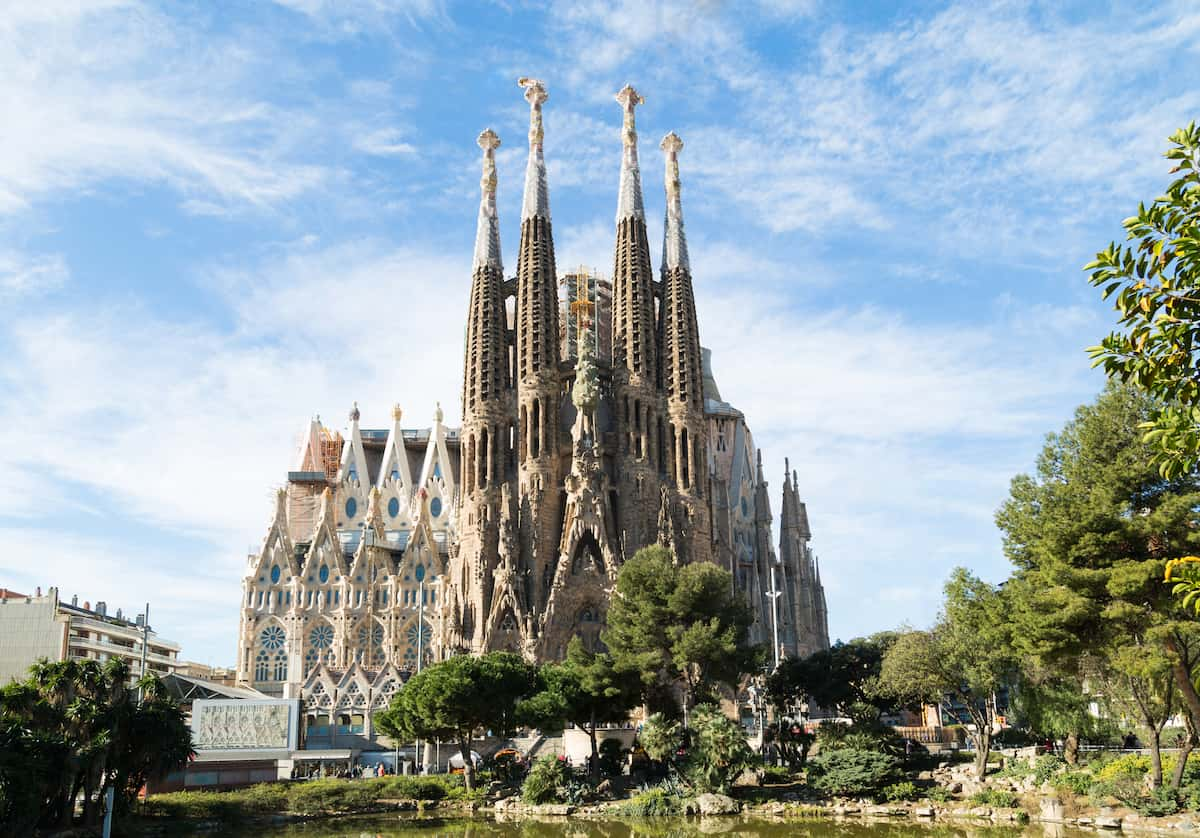
Barcelona is like an open-air museum of architecture, with some of the most stunning and unique buildings you’ll ever see. From the Gothic wonders in the old city to the fantastical creations of Antoni Gaudí, the architecture here is a big part of what makes the city so special.
I live in Spain and have spent a lot of time wandering around Barcelona and let me tell you, I’m always amazed at the architectural stories each street and building has to tell.
So, what exactly about Barcelona’s architecture makes it so famous and fascinating – in fact, it’s easily one of the things that Barcelona is best known for!
Well, let me take you from the awe-inspiring Sagrada Familia to the quirky and colorful Park Güell, through the historic charm of the Gothic Quarter and past many that are more off the beaten path. You’ll soon see just why Barcelona’s a paradise for architecture buffs and casual admirers alike.
Planning a trip to Barcelona last minute?
If you’re booking your trip to Barcelona last minute, I’ve got you covered. Below are some of the top tours, hotels, and more!
⭐ Most popular sights in Barcelona
- Sagrada Familia – tickets often sell out weeks in advance so get your entry ticket here (or entry tickets AND a guided tour here)
- Park Güell – grab your skip-the-line entry
- Casa Batlló – click here for tickets and audio guide
🌍 Top tours in Barcelona
- Montserrat Tour, Monastery and Winery (great day trip!)
- Flamenco Show at Tablao Flamenco Cordobes (incredible night out)
- Tapas Walking Tour with Food, Wine, and History (all the highlights at once)
🛏️ Top hotels in Barcelona
- Ohla Barcelona (5-star luxury with an amazing rooftop pool)
- Seventy Barcelona (boutique hotel with beautiful décor)
- Àmfores Boutique Guest House (great budget option with superb location)
🚌 Want free public transport while you’re in Barcelona? Check out the Hola Barcelona travel card!
Most famous architecture in Barcelona
1. Sagrada Familia
If you’re visiting Barcelona, visiting the awe-inspiring Sagrada Familia should be at the top of your list. As arguably the most famous building in Barcelona, you really can’t miss it.
Designed by the world-renowned architect Antoni Gaudí, this magnificent basilica has been under construction for over a century and is slated for completion in the coming years.
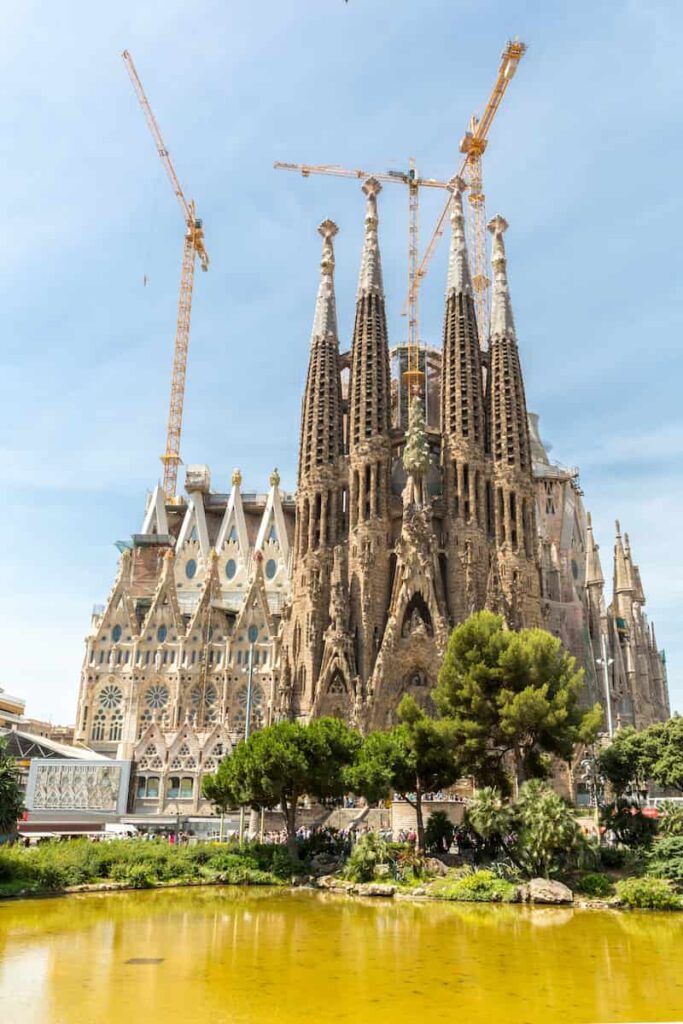
With its intricate facades, soaring spires, and breathtaking stained glass windows, it’s no wonder that the Sagrada Familia is considered a must-see for architecture enthusiasts and casual visitors alike.
PRO TIP: The Sagrada Familia is easily the most visited tourist site in Barcelona and tickets frequently sell out weeks ahead of time.
To make sure you don’t miss out, you need to book your tickets for the Sagrada Familia well in advance of your visit. As once they’re gone, they’re gone – and seeing inside is a definite must while you’re here.
As you explore this architectural marvel, you’ll be captivated by the delicate carvings, colorful stained glass windows, and undulating shapes that are synonymous with Gaudí’s unique style. The interior of the basilica is particularly stunning, with immense columns resembling tree trunks that support a canopy of branches, creating an ethereal, forest-like atmosphere.
Also, be sure to visit one of Barcelona’s best museums, which is located within the basilica, to learn more about Gaudí’s life, his architectural philosophy, and the ongoing construction of the Sagrada Familia.
2. Park Güell
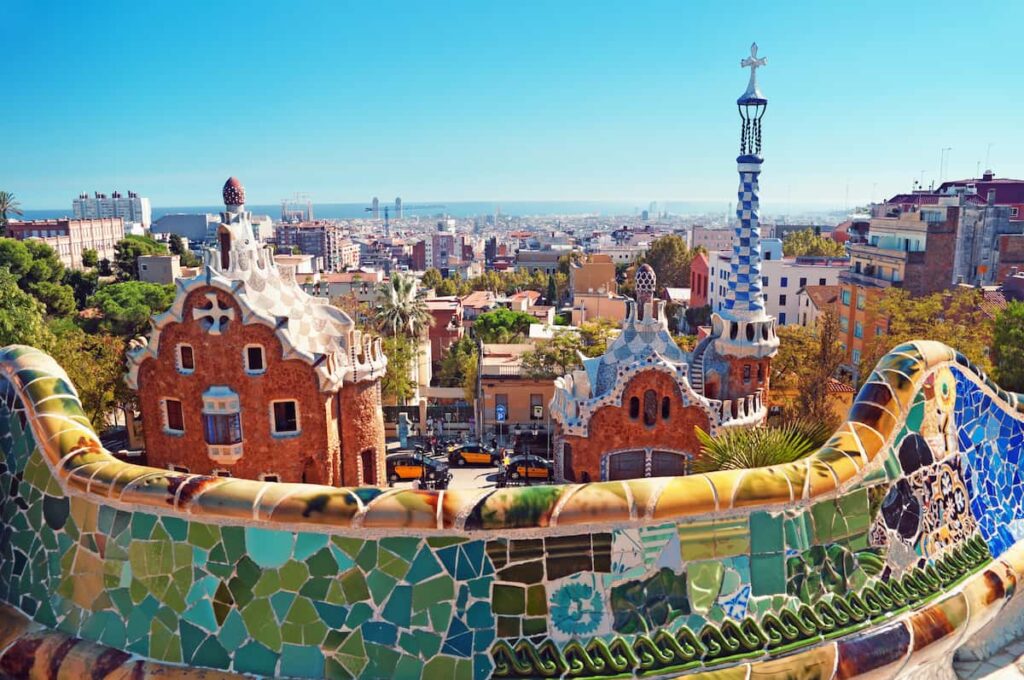
Park Güell is a colorful and whimsical oasis that invites you to step into a fairytale world. Also designed by Antoni Gaudí, this enchanting park is a showcase of his unparalleled creativity and imagination.
As you stroll through the gardens, marvel at the mosaic-covered terraces, fantastical sculptures, and serpentine benches that seem to defy the laws of gravity. The park’s main terrace is a particular highlight, featuring the iconic serpentine bench adorned with colorful, broken ceramic tiles, and offering spectacular views of the city and the Mediterranean Sea.
Don’t miss the charming Hansel and Gretel-inspired gatehouses and the monumental staircase, which is guarded by the famous mosaic salamander known as “El Drac.” Park Güell isn’t only a showcase of Gaudí’s unparalleled artistry but also a retreat where you can relax, take in the stunning views of Barcelona, and snap some Instagram-worthy photos of your unforgettable experience.
FYI: If you’re looking to visit both the Sagrada Familia and Park Güell and you’re short on time, you can get skip-the-line entry and a tour of both sights in one day right here.
3. Casa Batlló
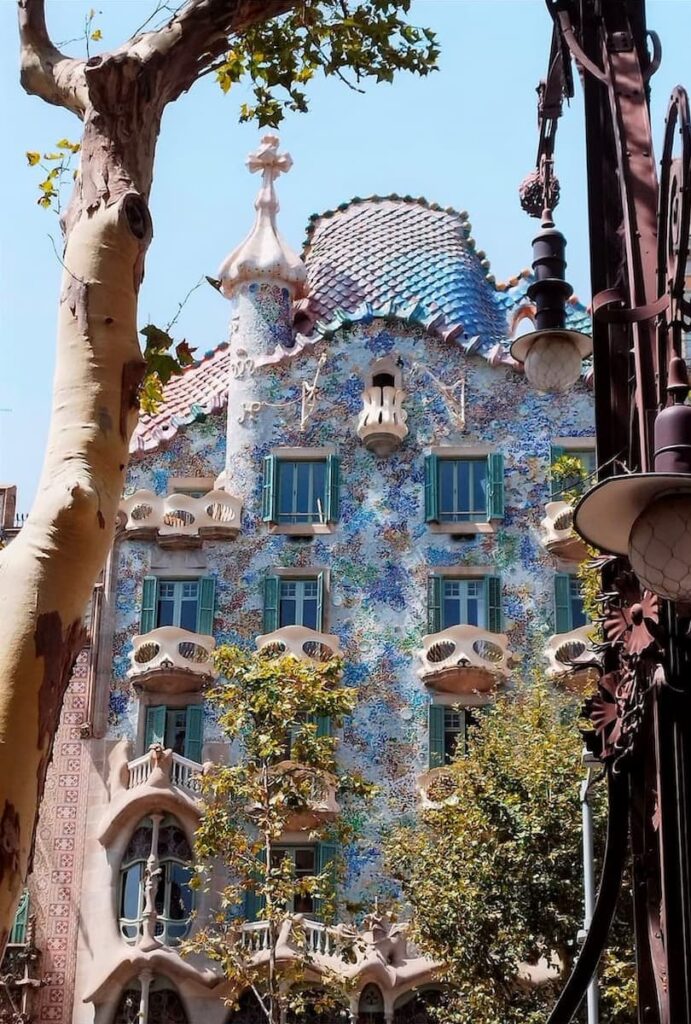
Casa Batlló, another masterpiece by Gaudí, is a must-visit for anyone who appreciates innovative design and breathtaking aesthetics. This one-of-a-kind Barcelona monument boasts a striking façade that’s reminiscent of the scales of a dragon, a nod to the legend of Saint George, the patron saint of Catalonia.
Located on the prestigious Passeig de Gràcia in the heart of the Eixample district, this UNESCO World Heritage site is affectionately known as the “House of Bones” due to its skeletal, organic façade. With its undulating lines, colorful mosaic tiles, and sinuous balconies, Casa Batlló is a true feast for the eyes and a must-see attraction for architecture lovers.
As you step inside, you’ll be transported to an enchanting world of whimsy and wonder, where every detail has been carefully designed to create a harmonious and immersive experience. The interior of Casa Batlló features a stunning array of organic shapes, natural motifs, and innovative design elements, such as the light-filled central atrium and the mesmerizing marine-inspired staircase.
And make sure you try to visit the rooftop terrace, where you’ll find Gaudí’s iconic “dragon’s back” chimney and spectacular views of the surrounding cityscape.
4. Casa Milà (La Pedrera)
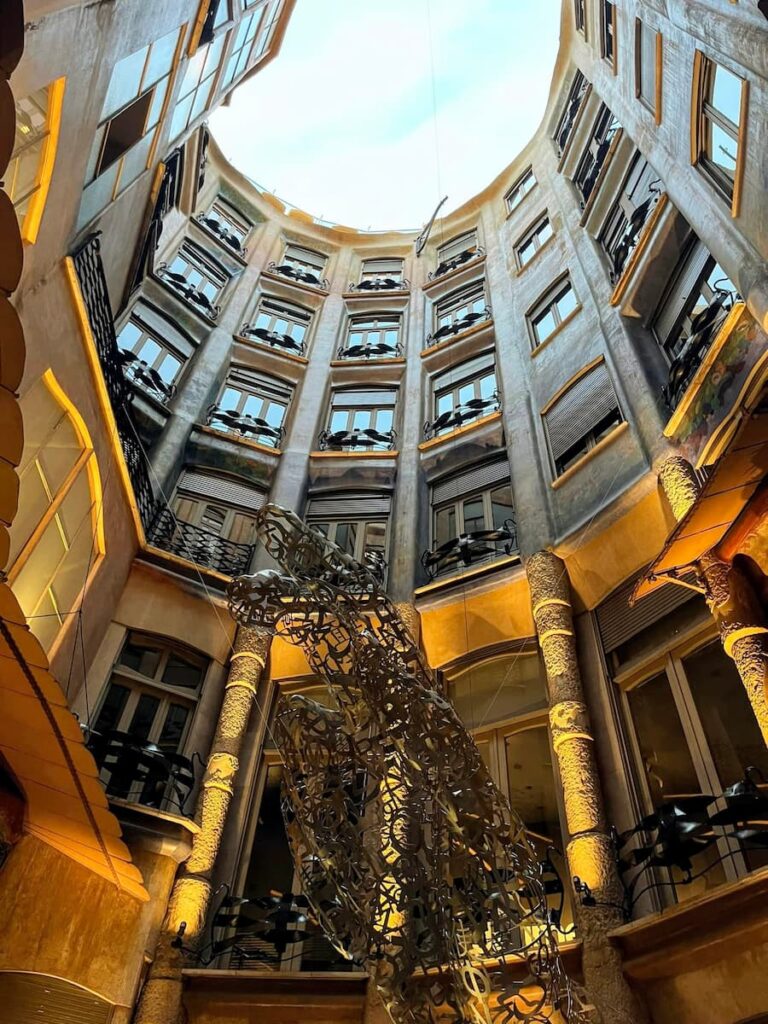
Casa Milà, affectionately known as “La Pedrera” (the stone quarry) due to its strikingly unconventional appearance, is yet another architectural marvel designed by Antoni Gaudí. This undulating, wave-like building seems to defy the rigid norms of traditional architecture, showcasing Gaudí’s boundless creativity and his deep connection with nature.
As you tour Casa Milà, you’ll be captivated by the innovative design elements, from the free-flowing courtyards to the ingeniously curved walls and ceilings. Like the nearby Casa Batlló, try to pick a tour that takes you to the rooftop, where you’ll find a mesmerizing array of sculptural chimneys that seem to have sprung to life from Gaudí’s imagination.
Experience the magic of La Pedrera, and you’ll understand why it’s considered one of Barcelona’s architectural jewels.
5. Palau de la Música Catalana
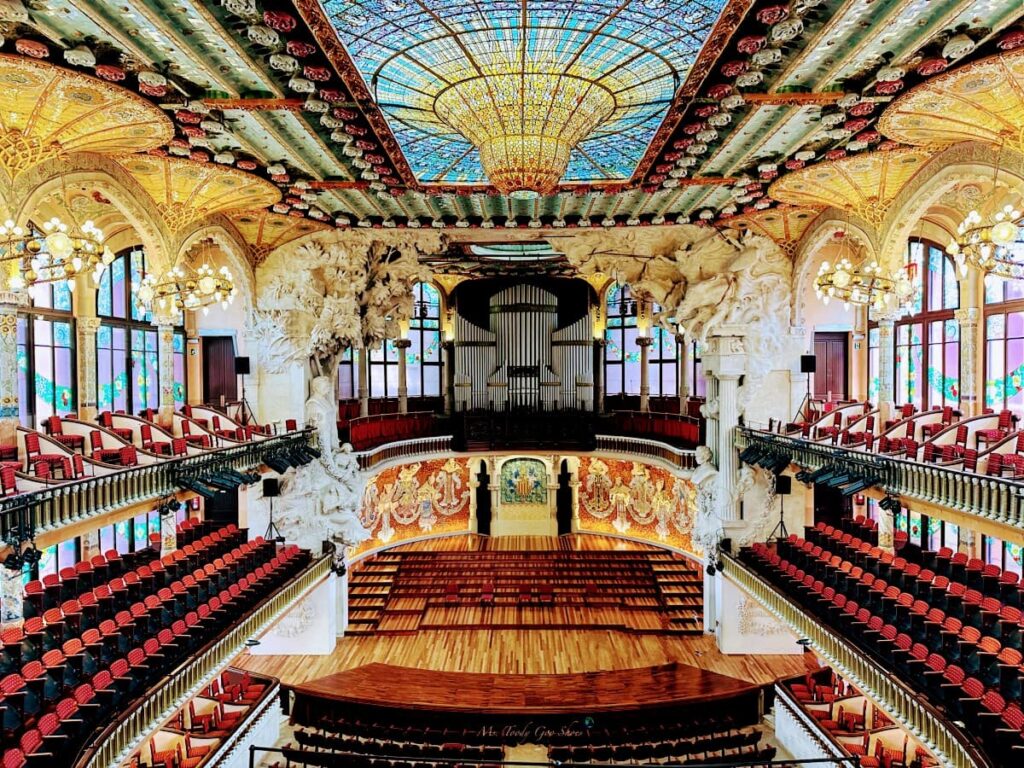
The Palau de la Música Catalana, a UNESCO World Heritage site, is a stunning concert hall that celebrates the rich musical heritage of Catalonia. Designed by architect Lluís Domènech i Montaner, this magnificent building is a masterpiece of Modernisme, the Catalan version of Art Nouveau.
From the moment you step inside, you’ll be swept away by the explosion of color, intricate mosaics, and exquisite stained glass that adorn the walls and ceilings. The centerpiece of the Palau is the awe-inspiring skylight, which bathes the concert hall in a kaleidoscope of natural light.
If you have the chance, attend a concert or take a guided tour to fully appreciate the beauty and acoustics of this extraordinary venue. The Palau de la Música Catalana is sure to leave you with lasting memories of Barcelona’s vibrant cultural scene.
6. Hospital de Sant Pau
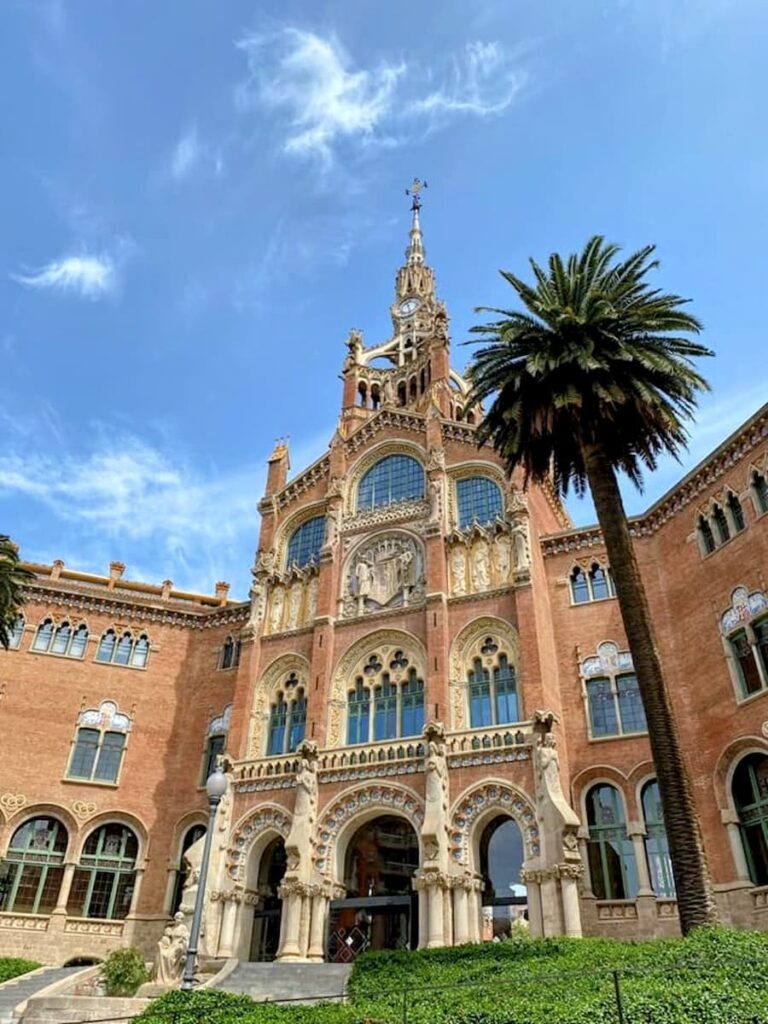
The Hospital de Sant Pau is a breathtaking complex of Modernist buildings that once served as a fully functioning hospital. Designed by architect Lluís Domènech i Montaner, it’s now considered a UNESCO World Heritage site and a shining example of Catalan Modernisme.
The hospital’s grounds are adorned with colorful mosaic tiles, intricate sculptures, and lush gardens that create a serene and inviting atmosphere. As you explore the beautifully restored pavilions, you’ll be struck by the harmonious blend of art, nature, and functionality that exemplifies Domènech i Montaner’s vision for a healing environment.
While it may seem unconventional to visit a former hospital, the Hospital de Sant Pau is a hidden gem that promises to delight your senses and provide a unique insight into Barcelona’s architectural heritage.
7. Gothic Quarter (Barri Gòtic)
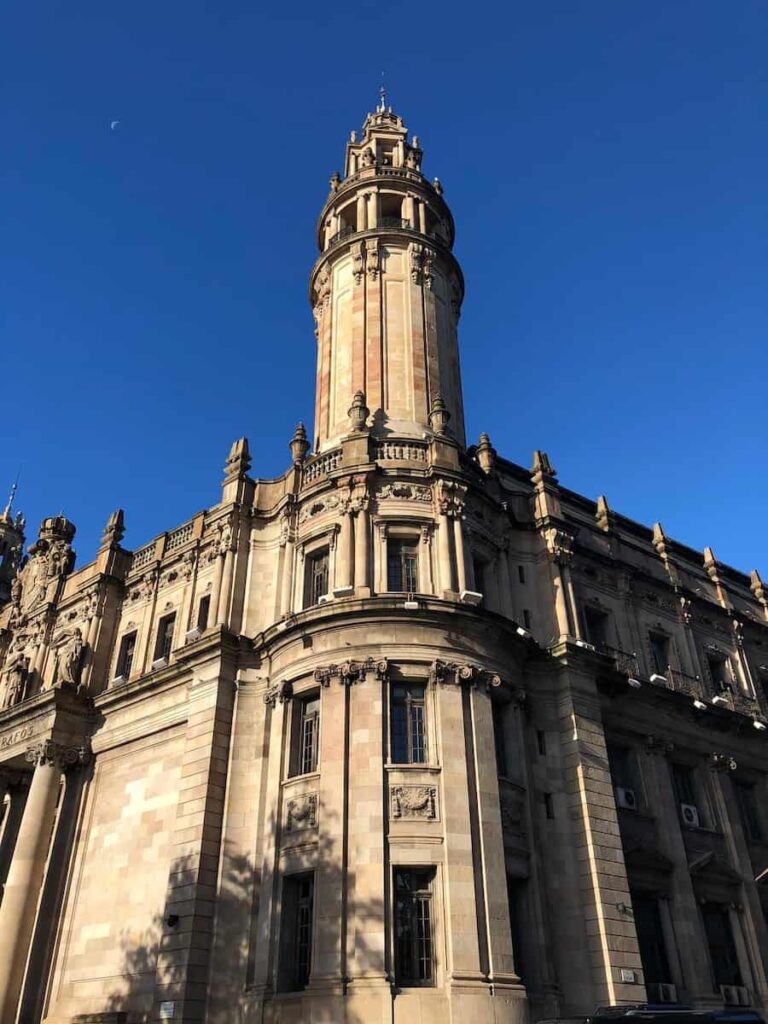
Stepping into the Gothic Quarter, or Barri Gòtic, is like taking a journey back in time to the heart of medieval Barcelona. This atmospheric neighborhood, with its narrow cobblestone streets and hidden squares, offers a fascinating contrast to the Modernist architecture found elsewhere in the city.
As you wander through the labyrinthine alleys, you’ll come across stunning examples of Gothic architecture, such as the majestic Barcelona Cathedral and the Basilica of Santa Maria del Pi. The Gothic Quarter is also home to the remnants of the ancient Roman walls and the bustling Plaça Reial, a lively square lined with cafés and palm trees.
To fully appreciate the charm and history of the Barri Gòtic, be sure to set aside some time to explore its captivating nooks and crannies. You’ll be enchanted by the stories and legends that seem to whisper from every corner of this timeless quarter.
If you’re looking for a great tour that will show you the highlights of Barcelona’s incredible 2,000+ year history, I definitely recommend this Old Town and Gothic Quarter Walking Tour.
You’ll be taken to the best parts of the oldest, most interesting parts of the city, while hearing stories about this time and the centuries that have followed. In particular, for first-timers, it’s a great way to see all the main spots at once.
8. Montjuïc Castle (Castell de Montjuïc)
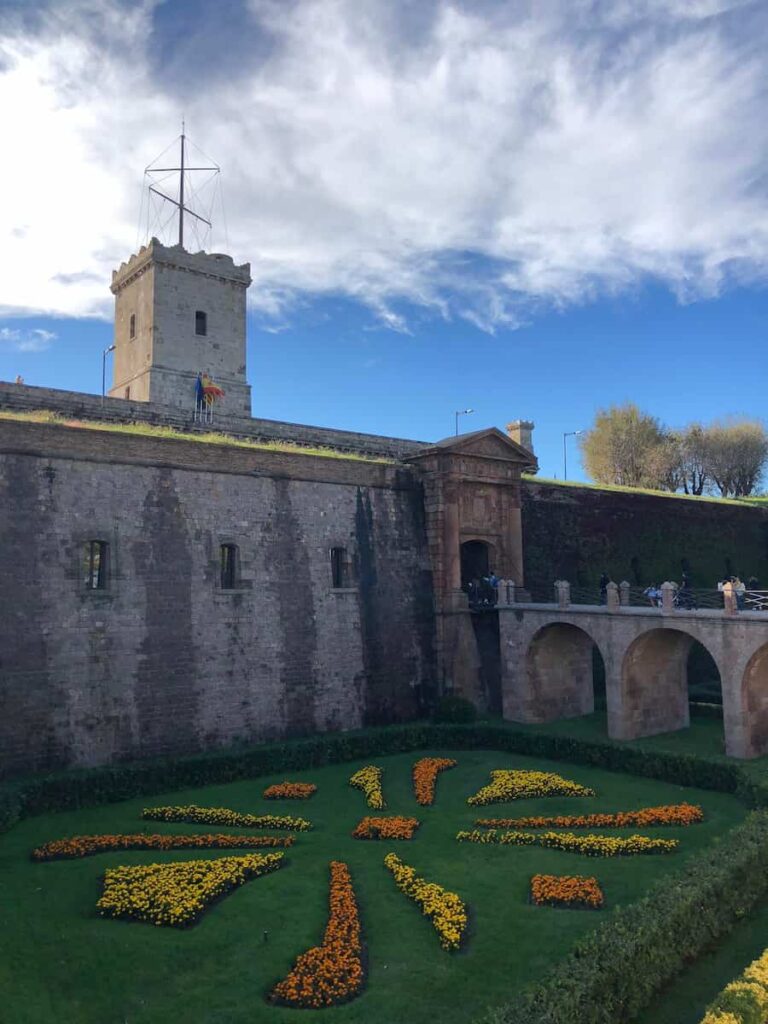
Perched atop the hill of Montjuïc, the imposing Montjuïc Castle offers breathtaking views of Barcelona from above, as well as the surrounding coastline. The castle has a long and tumultuous history, dating back to the 17th century when it was initially built as a fortress to defend the city.
Over the years, Montjuïc Castle has served various purposes, from a military stronghold to a prison and even an execution site during the Spanish Civil War. Today, the castle has been transformed into a cultural space and museum, offering visitors a fascinating insight into its storied past.
As you explore the castle grounds and ramparts, you’ll be captivated by the stunning vistas and the sense of history that pervades the ancient walls. Be sure to check the events calendar for temporary exhibitions, concerts, and other cultural activities that take place at Montjuïc Castle throughout the year.
This historic landmark isn’t only a testament to the resilience and strength of Barcelona but also a unique vantage point from which to appreciate the city’s beauty.
…and don’t miss out on easily the best way to get up to Montjuïc Castle – on the Montjuïc Cable Car!
You’ll get sweeping views of Barcelona as you head up the 2,460-foot (750-meter) run that lets you look over the whole region, from the Serra de Collserola to the Mediterranean Sea, with a bird’s-eye-view of iconic landmarks like the imposing Sagrada Familia.
And you don’t even have to walk back down as you can grab your return ticket here!

What’s your perfect destination for your dream trip to Spain?
Want to discover a city or live your island dreams?
Embrace the food scene or step through the pages of history?
Whatever your travel style, discover the perfect Spanish city to add to your trip here!
9. Barcelona Cathedral (Catedral de Barcelona)
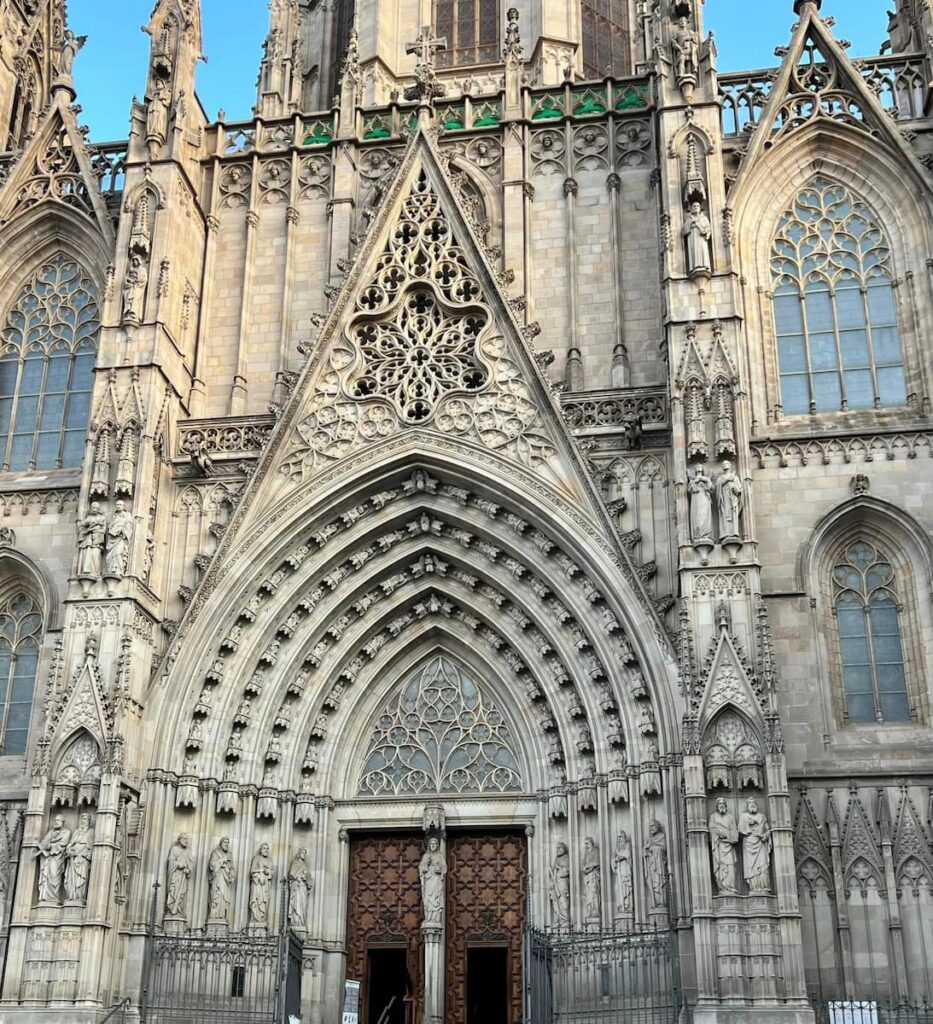
The Barcelona Cathedral, also known as the Cathedral of the Holy Cross and Saint Eulalia, is a breathtaking example of Gothic architecture that stands proudly in the heart of the Gothic Quarter. Dedicated to the city’s patron saint, Eulalia of Barcelona, this awe-inspiring cathedral dates back to the 13th century and is a testament to the rich history and artistic heritage of the city.
As you step inside, you’ll be captivated by the soaring vaulted ceilings, intricate stained glass windows, and majestic altarpieces that adorn the nave and chapels. Be sure to explore the serene cloister, where you’ll find a lush garden, a tranquil fountain, and a family of 13 white geese, which symbolize the age of Saint Eulalia when she was martyred.
Whether you’re seeking a moment of quiet contemplation or simply wish to marvel at the architectural splendor, the Barcelona Cathedral is a must-visit during your time in the city.
10. La Boqueria Market (Mercat de la Boqueria)
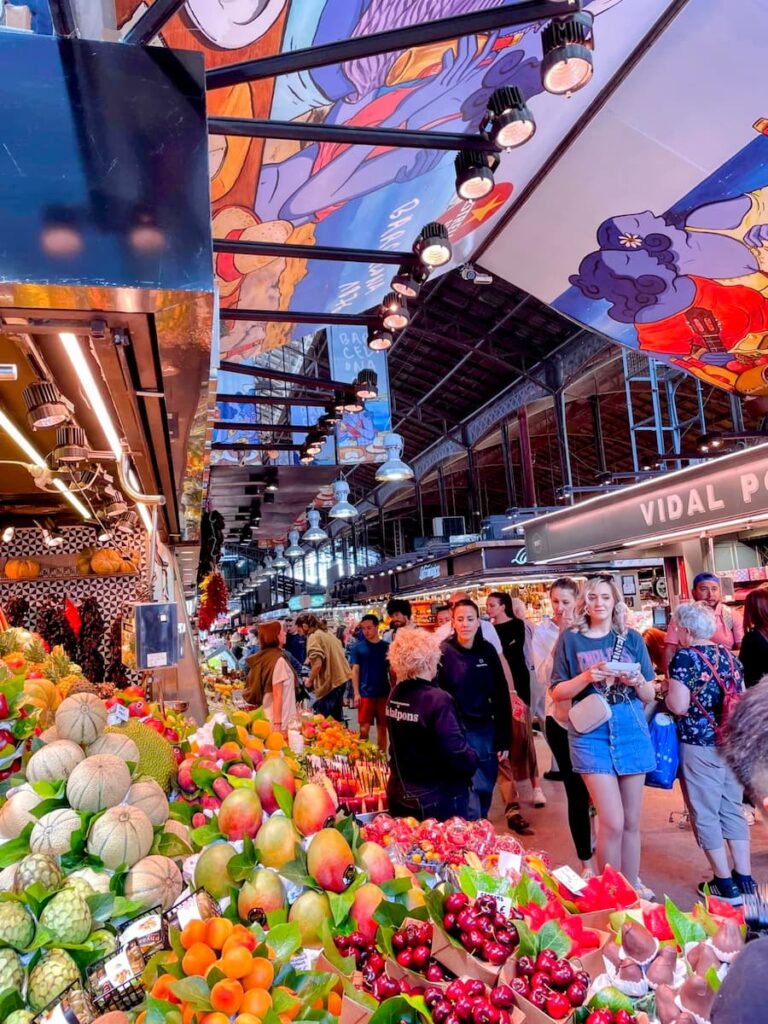
La Boqueria Market, officially known as Mercat de la Boqueria, is a vibrant and bustling marketplace that has been the beating heart of Barcelona’s food scene for centuries. Located just off the famous La Rambla, this lively market is a feast for the senses, with a kaleidoscope of colors, enticing aromas, and a symphony of sounds that reflect the city’s culinary soul.
As you meander through the maze of stalls, you’ll discover a dazzling array of fresh fruits, vegetables, seafood, meats, cheeses, and other local delicacies. Take the chance to sample some of the mouthwatering tapas and freshly-squeezed juices available at the numerous bars and food stands.
La Boqueria Market is more than just a place to shop for groceries; it’s an unforgettable experience that captures the essence of Barcelona’s rich food culture and is a must-visit for any food lover.
One of my top recommendations for things to do in Barcelona is this paella cooking experience.
You’ll start by being shown around La Boqueria market with an expert chef, who’ll explain how to pick out the best ingredients.
From there, you’ll be taken to the main event – a workshop on how to make your very own paella, tapas and sangria – before getting to eat and drink all your hard work. It’s a great way to experience the culinary side of Barcelona!
11. Santa Maria del Mar
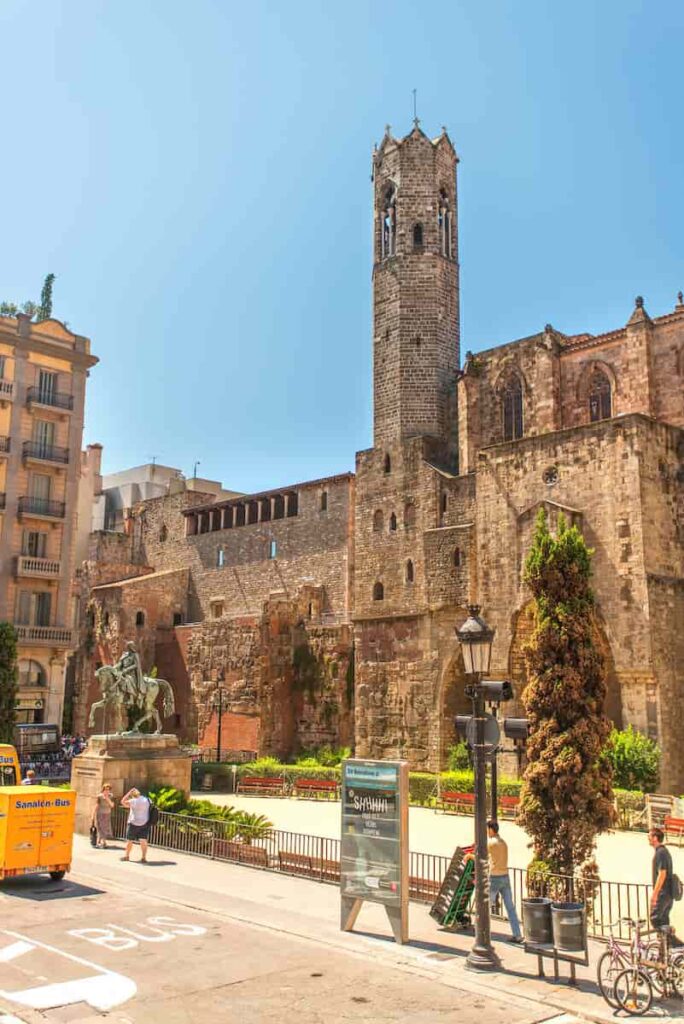
Santa Maria del Mar is a stunning basilica located in the heart of Barcelona’s El Born neighborhood, a testament to the city’s maritime history and the skill of its medieval craftsmen. Often referred to as the “Cathedral of the Sea,” this magnificent church was built in the 14th century in the Catalan Gothic style and stands as a symbol of the city’s thriving merchant community.
The moment you step inside, you’ll be struck by the sense of light and space created by the soaring columns, graceful arches, and towering stained glass windows. The basilica’s elegant simplicity and harmonious proportions create an atmosphere of serenity and reflection, providing a peaceful retreat from the bustling city outside.
Be sure to climb to the rooftop for panoramic views of Barcelona, and immerse yourself in the fascinating history of Santa Maria del Mar, a true architectural gem that has stood the test of time.
12. Casa Amatller
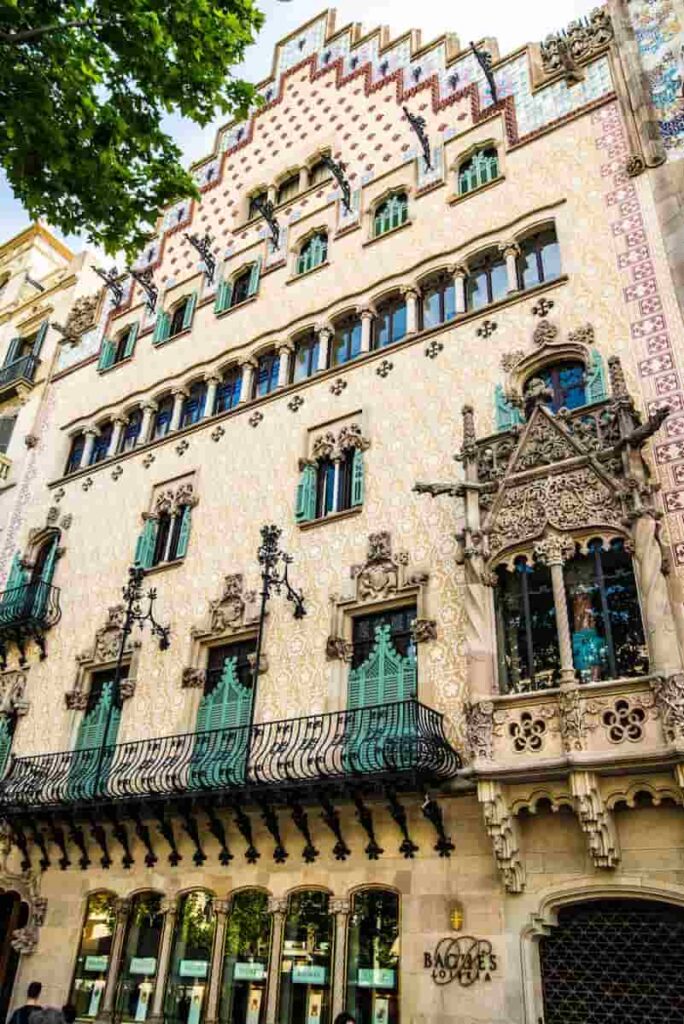
Nestled in the heart of Barcelona’s famous “Block of Discord,” Casa Amatller is a dazzling example of Modernist architecture that exudes elegance and sophistication. Designed by architect Josep Puig i Cadafalch, this striking building is a harmonious blend of Catalan Gothic and Flemish influences, making it a true standout among its neighbors.
The façade features intricate sculptures, colorful ceramics, and an eye-catching stepped gable that resembles a Dutch townhouse. As you tour the exquisitely restored interiors, you’ll be transported to the turn of the 20th century, when Barcelona’s wealthy elite lived in the height of luxury.
From the sumptuous furnishings to the detailed stained glass windows, Casa Amatller is a delightful testament to the opulence and creativity of the Modernist era.
13. Casa Lleó Morera
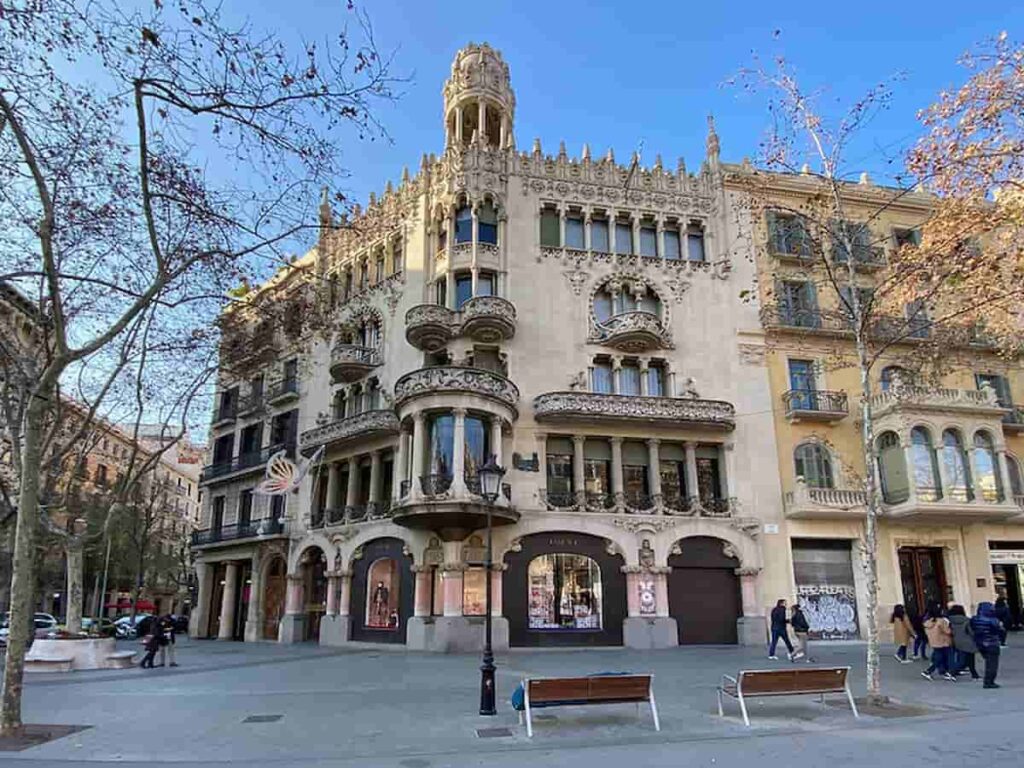
Casa Lleó Morera, another gem on the illustrious “Block of Discord,” is a remarkable showcase of Lluís Domènech i Montaner’s architectural prowess. This exquisite building stands out with its elegant curved lines, intricate floral motifs, and dazzling array of materials, such as wood, stone, glass, and ceramics.
The name “Lleó Morera” translates to “lion” and “mulberry tree,” both of which feature prominently in the building’s decorative elements, symbolizing strength and growth. As you explore the interiors, you’ll be captivated by the masterful craftsmanship and attention to detail that permeates every corner of the house.
From the grand staircase to the stunning stained glass windows, Casa Lleó Morera offers a fascinating glimpse into the lavish lifestyle of Barcelona’s high society during the Modernist period.
14. Torre Agbar
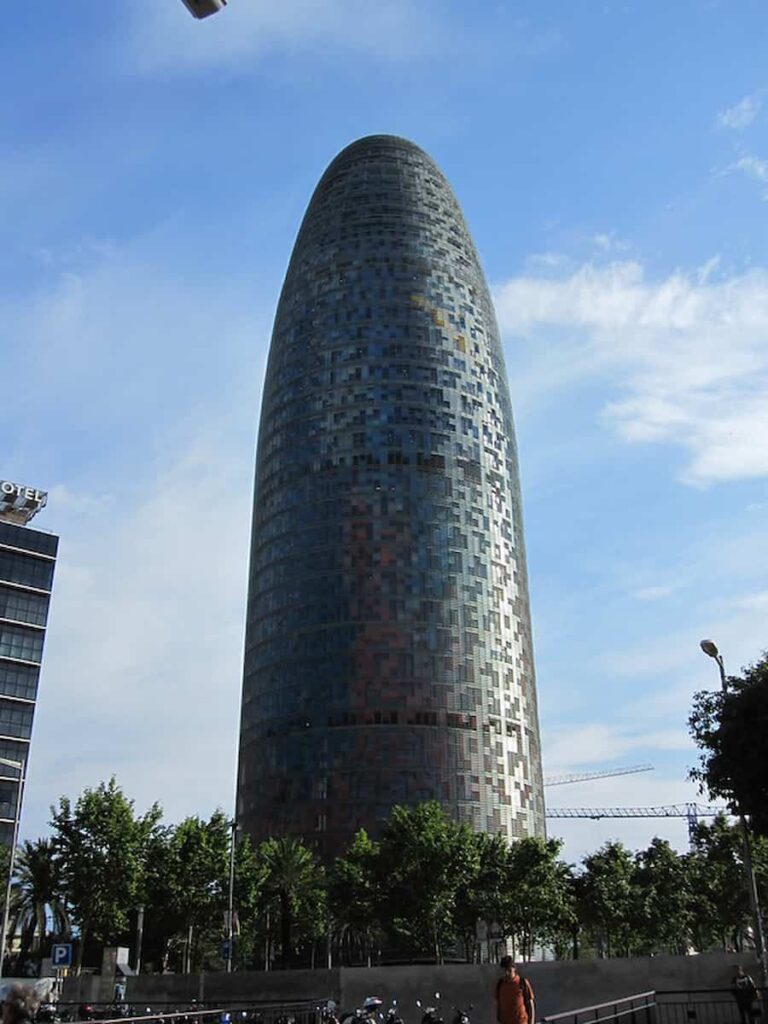
The Torre Agbar is a modern architectural marvel that has quickly become an iconic symbol of Barcelona’s innovative spirit. Designed by French architect Jean Nouvel, this 38-story skyscraper was inspired by the shape of a geyser and the rugged peaks of Montserrat, Catalonia’s famous mountain range.
The building’s distinctive silhouette is accentuated by over 4,500 colorful glass panels that create a mesmerizing play of light during the day and transform into a dazzling light show at night.
Although the interior of the Torre Agbar is not open to the public, its impressive façade is a must-see for anyone interested in contemporary architecture. Make sure to capture some stunning photos of this modern masterpiece as it lights up the Barcelona skyline.
15. Magic Fountain of Montjuïc
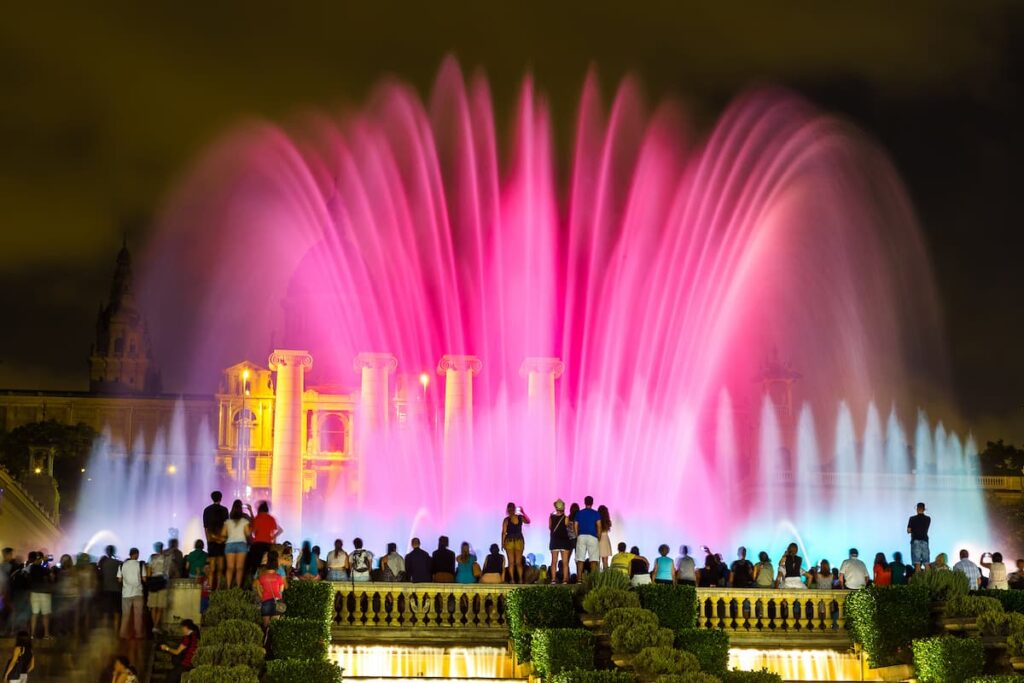
The Magic Fountain of Montjuïc is a must-see attraction that promises to enchant visitors of all ages. Designed by Carles Buïgas for the 1929 International Exposition, this captivating fountain is located at the foot of Montjuïc Hill, near the Plaça d’Espanya.
The true magic of the fountain comes to life during the evening light and music shows, when the waters dance in a mesmerizing display of color, light, and sound. With over 7,000 individual jets and a vast array of hues, the fountain creates a breathtaking spectacle that’s synchronized to a diverse selection of music, ranging from classical to contemporary.
Keep in mind that it’s a good idea to check the schedule and arrive early to secure a good viewing spot, as it’s always a popular spot for tourists (not to mention that, at the moment, it’s not always running due to the drought, so check the site for this too). But when it’s on, that popularity is for good reason, as the Magic Fountain of Montjuïc is a dazzling experience that you won’t want to skip during your visit to Barcelona.
16. Camp Nou

Camp Nou, home to the world-famous FC Barcelona, is a true mecca for football fans from around the globe. As the largest stadium in Europe and the third-largest in the world, Camp Nou boasts an impressive capacity of over 99,000 spectators, creating an electrifying atmosphere on match days.
But even if you’re not attending a game, a visit to this iconic stadium is a must for any sports enthusiast. Take a guided tour of the stadium to explore the hallowed grounds, walk through the players’ tunnel, and experience the awe-inspiring view from the pitch.
The tour also includes access to the FC Barcelona Museum, where you can explore the rich history of the club, marvel at the glittering trophy collection, and discover the legends who have graced the Camp Nou pitch. Whether you’re a die-hard football fan or simply curious about the sport, a visit to Camp Nou offers a thrilling and unforgettable experience.
17. Casa Vicens

Casa Vicens, Antoni Gaudí’s first major architectural commission, is a fascinating glimpse into the early career of this visionary architect. Completed in 1888, this vibrant and eclectic building marks the beginning of Gaudí’s illustrious journey into the world of Modernisme.
The building is a stunning fusion of Moorish, Oriental, and Catalan influences, with colorful ceramic tiles, intricate wrought-iron balconies, and playful geometric patterns adorning its façade. As you explore the interiors, you’ll discover Gaudí’s signature organic shapes, bold colors, and innovative use of natural light.
But wandering through the lush garden is just as much of a highlight, as it offers a tranquil oasis in the heart of the bustling Gràcia neighborhood. Casa Vicens is a lesser-known but equally impressive gem in Gaudí’s architectural legacy, and a must-visit for anyone interested in the early stages of his remarkable career.
18. Arc de Triomf
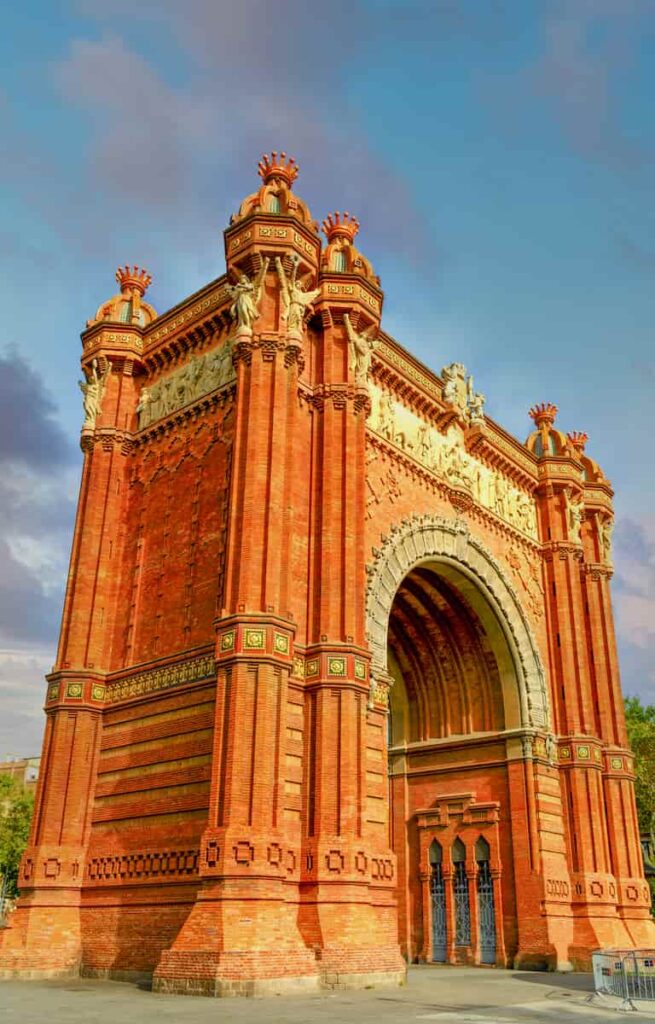
The Arc de Triomf, one of Barcelona’s most iconic landmarks, is a stunning triumphal arch that serves as a gateway to the picturesque Parc de la Ciutadella. Designed by architect Josep Vilaseca i Casanovas for the 1888 Universal Exposition, the arch showcases a unique combination of Neo-Mudéjar and Modernist styles.
Crafted from red brick and adorned with intricate sculptures and friezes, the Arc de Triomf symbolizes progress and the spirit of innovation that characterized the late 19th century. As you stroll along the tree-lined pedestrian boulevard leading up to the arch, take a moment to admire the detailed carvings that celebrate Barcelona’s cultural and artistic heritage.
The Arc de Triomf is not only a beautiful piece of architecture but also a testament to the city’s enduring spirit of creativity and progress. Be sure to capture some memorable photos of this iconic landmark during your visit to Barcelona.
19. Barcelona Pavilion (Pabellón de Barcelona)
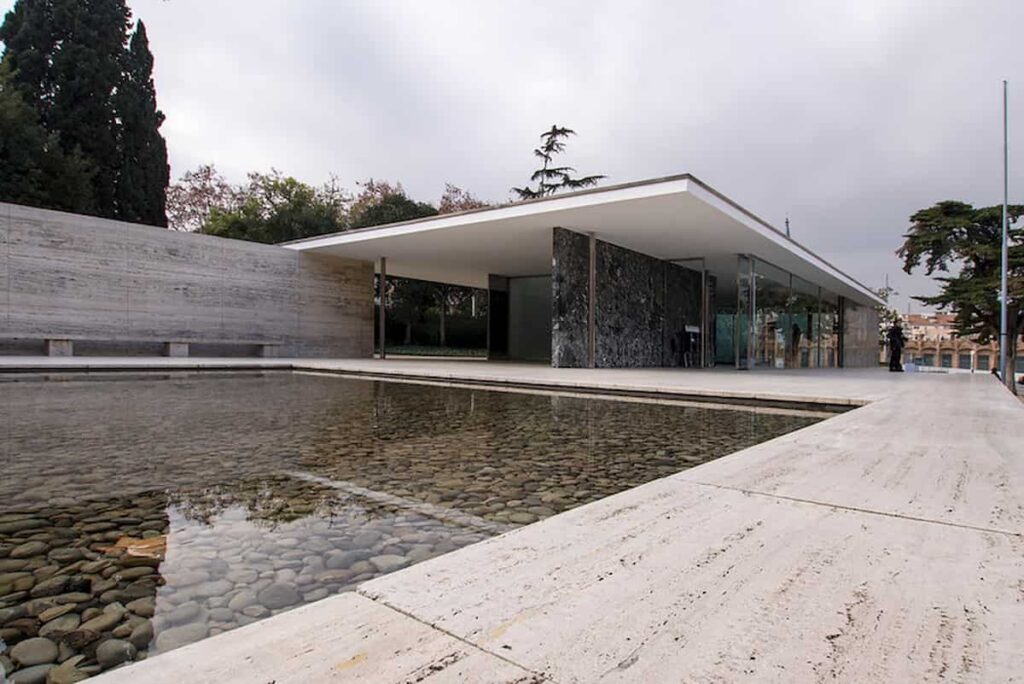
The Barcelona Pavilion, also known as the Pabellón de Barcelona or the German Pavilion, is a symbol of modern architecture and a testament to the genius of the renowned architect Ludwig Mies van der Rohe. Originally designed for the 1929 International Exposition, the pavilion served as the German Pavilion before being dismantled and later reconstructed in the 1980s.
This sleek and minimalist structure features clean lines, open spaces, and the masterful use of materials like glass, steel, and marble. As you walk through the pavilion, you’ll be struck by its elegant simplicity and perfect harmony of form and function.
The iconic Barcelona Chair, also designed by Mies van der Rohe, adds a touch of sophistication and style to the space. The Barcelona Pavilion is an essential stop for architecture enthusiasts, offering a glimpse into the birth of modern design and a chance to appreciate the timeless beauty of this architectural masterpiece.
20. Torre de Collserola
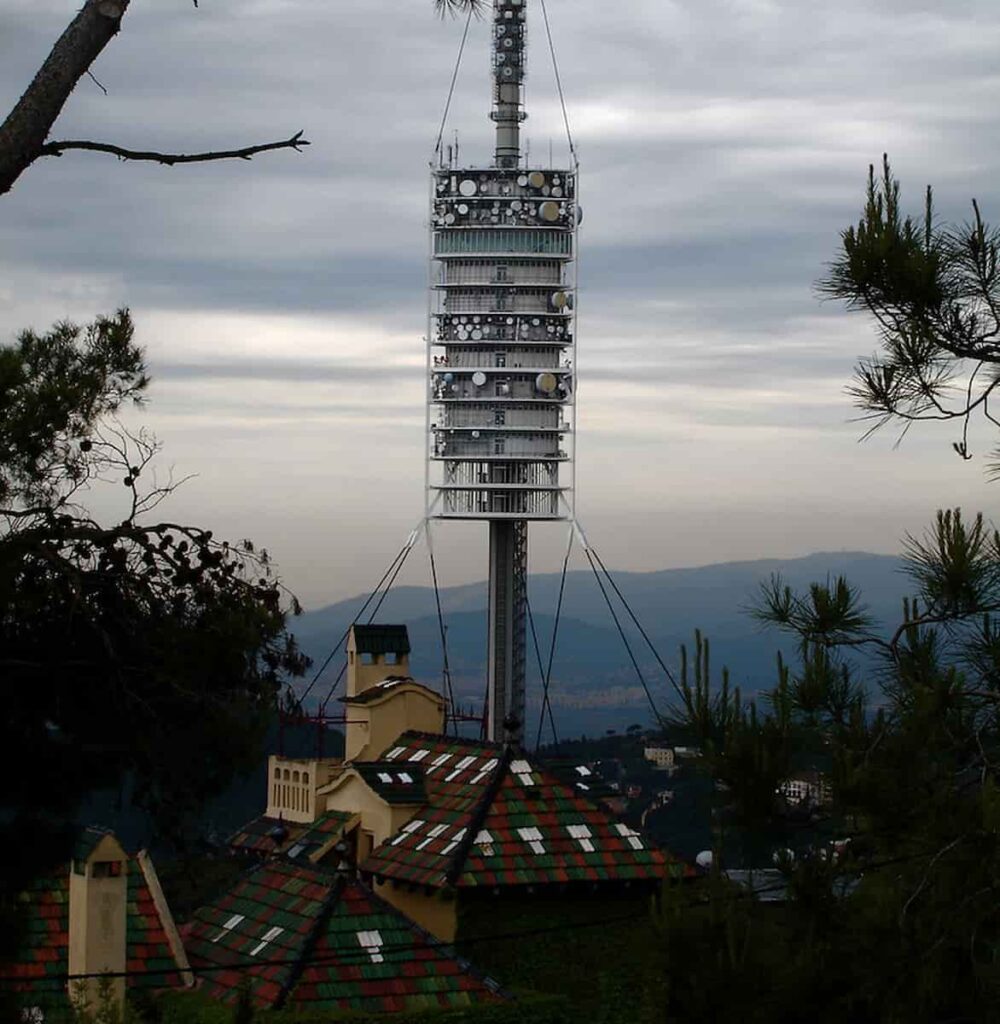
The Torre de Collserola, designed by British architect Sir Norman Foster, is an impressive communications tower that soars above the city on the scenic Collserola Ridge. Completed in 1992 for the Barcelona Olympics, this slender, futuristic structure stands 288 meters (945 feet) tall, offering unparalleled panoramic views of the city and the surrounding countryside.
The tower’s unique design features a series of circular platforms supported by a central concrete core and stabilized by a network of steel cables. Visitors can take an elevator to the observation deck, located 115 meters (377 feet) above ground, to enjoy breathtaking 360-degree vistas of Barcelona, the Mediterranean Sea, and the rugged mountains beyond.
A visit to the Torre de Collserola provides a memorable experience that combines innovative architecture with stunning natural beauty, making it a must-see attraction for anyone seeking a bird’s-eye view of the city.
21. Casa de les Punxes (House of Spikes)
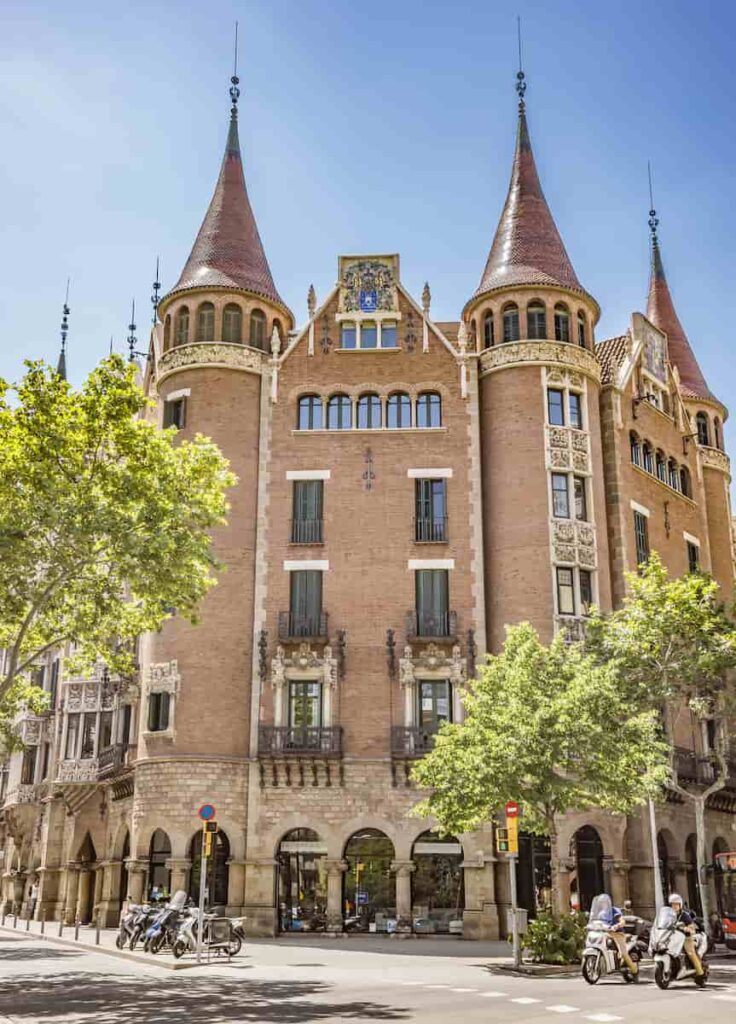
Casa de les Punxes, also known as the House of Spikes, is an eye-catching Modernist building that stands proudly in the heart of the Eixample district. Designed by architect Josep Puig i Cadafalch, this impressive structure resembles a medieval fortress with its imposing towers and pointed rooftops, earning it the nickname “House of Spikes.”
The building’s façade is adorned with intricate wrought-iron balconies, colorful ceramics, and elaborate sculptures that reflect the rich cultural heritage of Catalonia. Casa de les Punxes is not only a striking example of Modernist architecture but also a symbol of the creativity and imagination that flourished during the early 20th century in Barcelona.
Make sure you take the opportunity to visit this architectural gem and learn more about its fascinating history through its interactive exhibitions and guided tours.
22. Casa Calvet
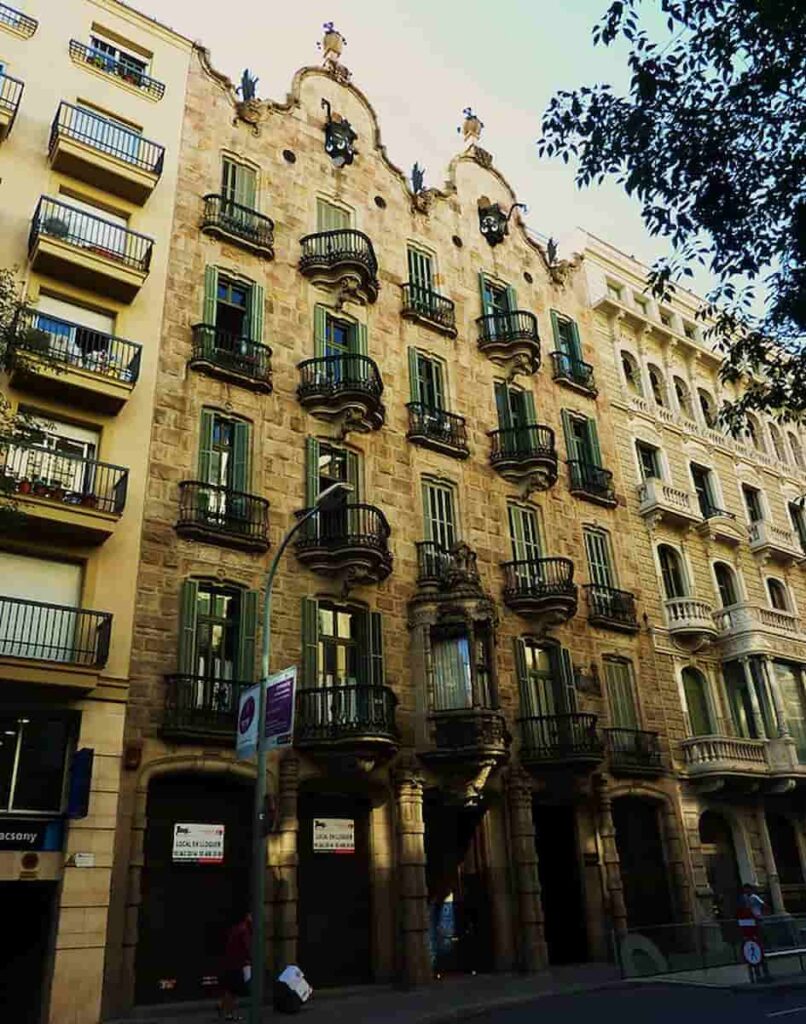
Casa Calvet is an elegant Modernist building designed by the renowned architect Antoni Gaudí. Located in the heart of the Eixample district, this lesser-known gem showcases Gaudí’s unique aesthetic and innovative design techniques.
Completed in 1900, Casa Calvet was originally designed as a residential building and won the prestigious City Council award for the best building in the same year. The building’s façade features a harmonious blend of Baroque and Modernist elements, with intricately carved stonework, wrought-iron balconies, and a symmetrical layout that departs from Gaudí’s typical organic shapes.
Although the interior of Casa Calvet is not open to the public, its beautiful façade is well worth a visit to gain a deeper appreciation for Gaudí’s early work and his evolving architectural style.
23. Santa Maria del Pi
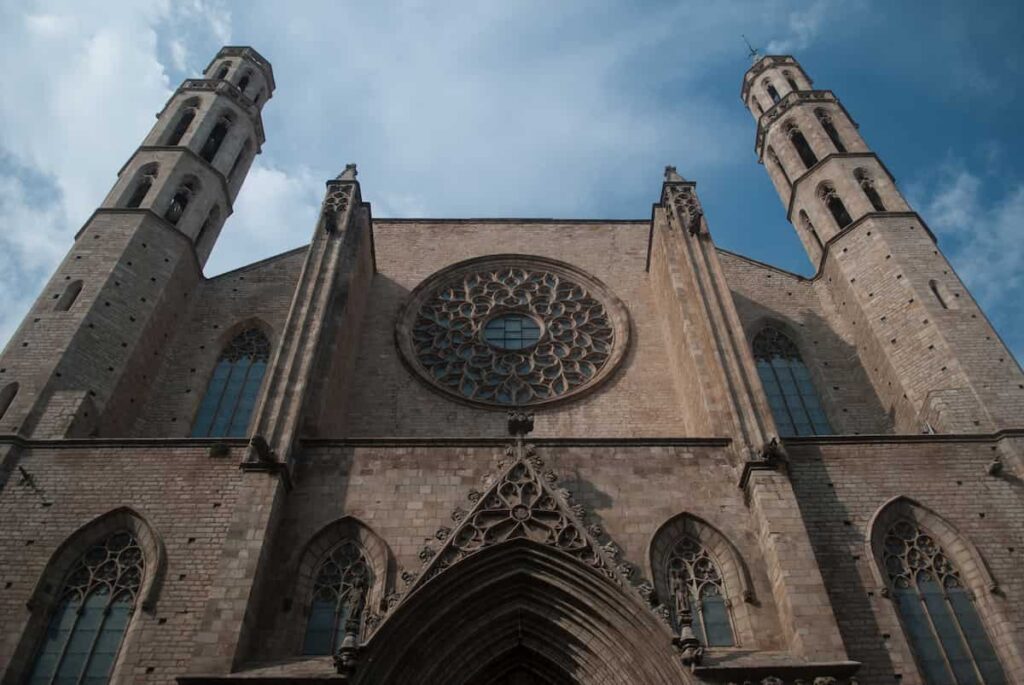
Santa Maria del Pi, or St. Mary of the Pine Tree, is a beautiful Gothic church located in the heart of Barcelona’s Gothic Quarter. Dating back to the 14th century, this historic church boasts an impressive façade with a large rose window, one of the largest in Europe, and a richly decorated main portal.
The interior of Santa Maria del Pi is characterized by its tall, slender columns and soaring ribbed vaults, which create a sense of lightness and space. The church is also home to a magnificent 15th-century Gothic altarpiece dedicated to the Virgin Mary, as well as a collection of medieval tombstones and artifacts.
If you’ve got some energy left, make sure you climb the bell tower for a stunning panoramic view of the Gothic Quarter and the city beyond. You’ll see why Santa Maria del Pi is not only an architectural treasure but also a peaceful sanctuary where you can escape the bustling streets of Barcelona and immerse yourself in the city’s rich history and spiritual heritage.
24. Casa de la Ciutat (City Hall)
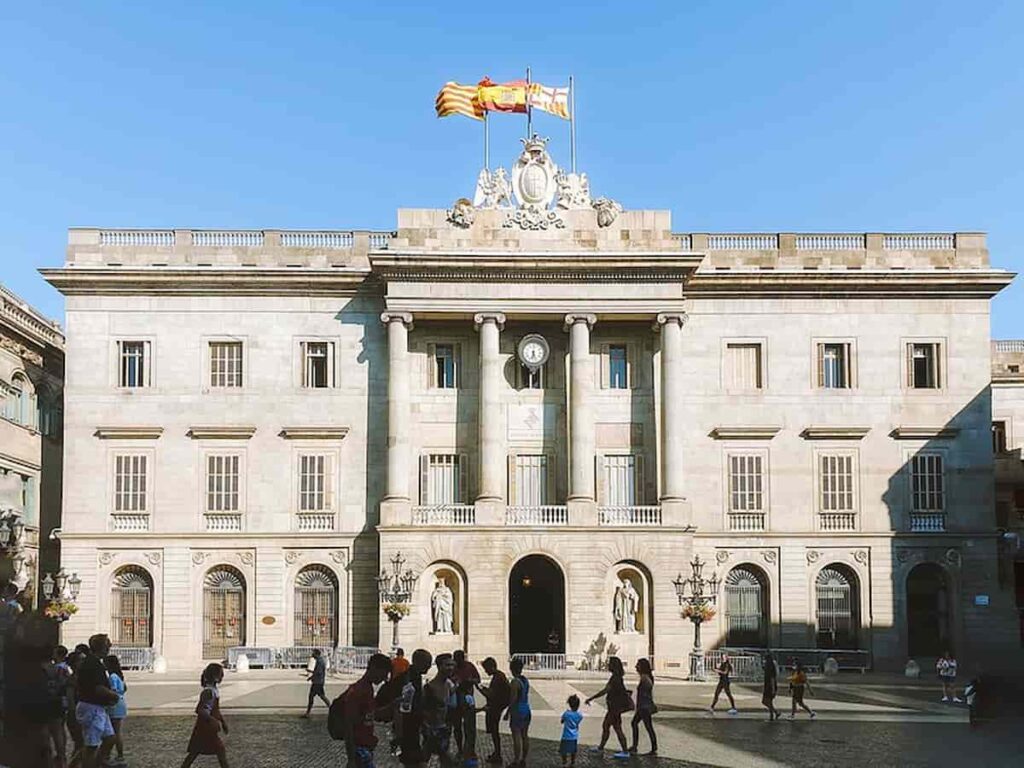
Casa de la Ciutat, or City Hall, is a striking architectural landmark that has been the seat of Barcelona’s local government for centuries. Located in the historic Plaça de Sant Jaume, this impressive building is a harmonious blend of Gothic and Neo-Classical styles, reflecting the rich history and diverse influences that have shaped the city.
The Gothic façade, which dates back to the 14th century, features intricate stone carvings and ornate decorations, including the emblem of Barcelona and statues of city’s patrons, Saint Eulalia and Saint George. The Neo-Classical façade, added in the 19th century, faces the square and provides a stately contrast to the Gothic exterior.
While the interior of Casa de la Ciutat is not always open to the public, guided tours are occasionally available, offering visitors a chance to explore the stunning Saló de Cent, the historic council chamber, and other majestic rooms.
25. Fira Barcelona (Barcelona Trade Fair)
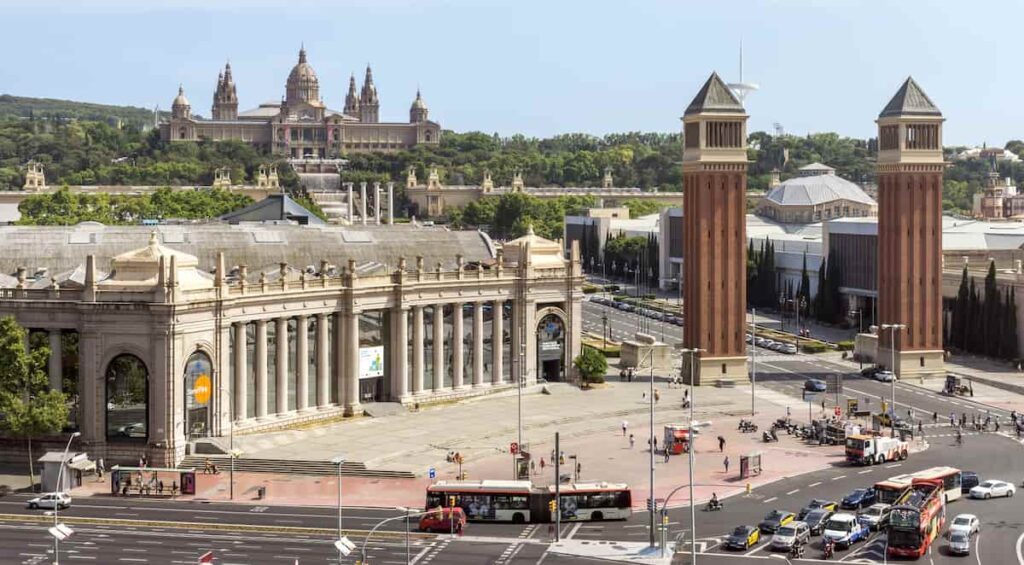
Fira Barcelona, also known as the Barcelona Trade Fair, is one of Europe’s leading exhibition and conference centers, hosting a wide range of events and trade shows throughout the year. With two expansive venues, Montjuïc and Gran Via, Fira Barcelona boasts state-of-the-art facilities and cutting-edge design, providing an impressive stage for international events and a testament to the city’s innovative spirit.
The Montjuïc venue, designed by renowned architect Josep Lluís Sert, features a series of modern pavilions that surround the historic Palau Nacional, while the Gran Via venue, designed by Japanese architect Toyo Ito, showcases a striking wave-like roof and a sustainable design that incorporates natural light and energy-saving technologies.
Whether you’re attending a conference, trade show, or cultural event, Fira Barcelona offers a vibrant and dynamic setting that reflects Barcelona’s status as a global hub for innovation and creativity.
26. Palau Güell
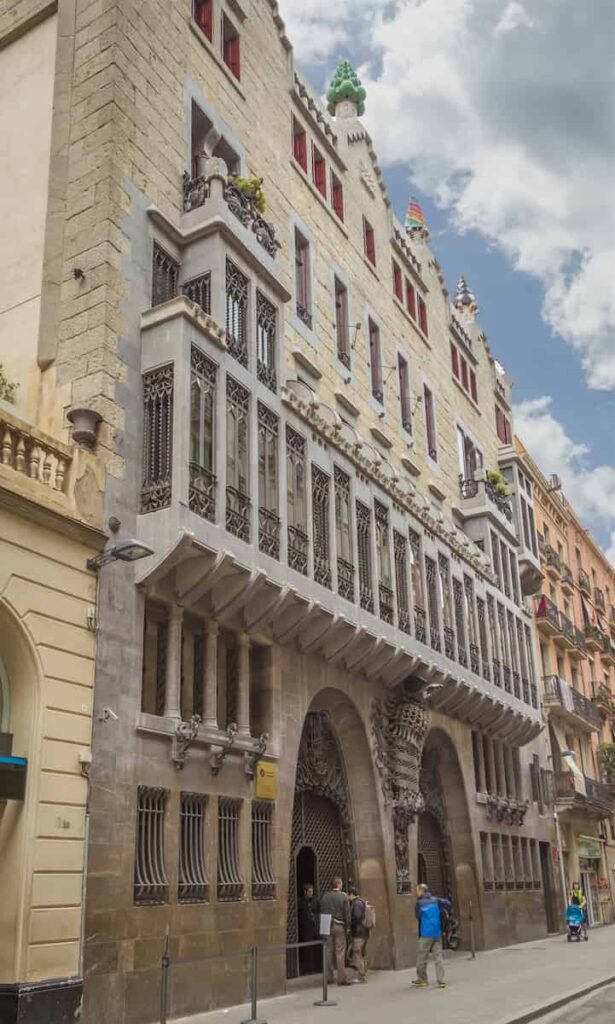
Palau Güell, one of Antoni Gaudí’s early masterpieces, is a magnificent urban mansion located in the Raval neighborhood, just a short walk from La Rambla. Commissioned by the industrialist Eusebi Güell, a close friend and patron of Gaudí, this unique building showcases the architect’s distinctive style and innovative design techniques.
Completed in 1890, Palau Güell features an impressive façade adorned with intricate ironwork, colorful ceramics, and playful sculptures. The interior is a stunning display of Gaudí’s mastery of space and light, with a grand central hall, intricately carved wooden ceilings, and a stunning array of stained glass windows.
Don’t miss the rooftop terrace, where you’ll find a collection of whimsical chimneys and breathtaking panoramic views of the city. Palau Güell is a must-visit attraction for anyone interested in Gaudí’s early work and the origins of his unique architectural vision.
27. Teatre Liceu (Gran Teatre del Liceu)
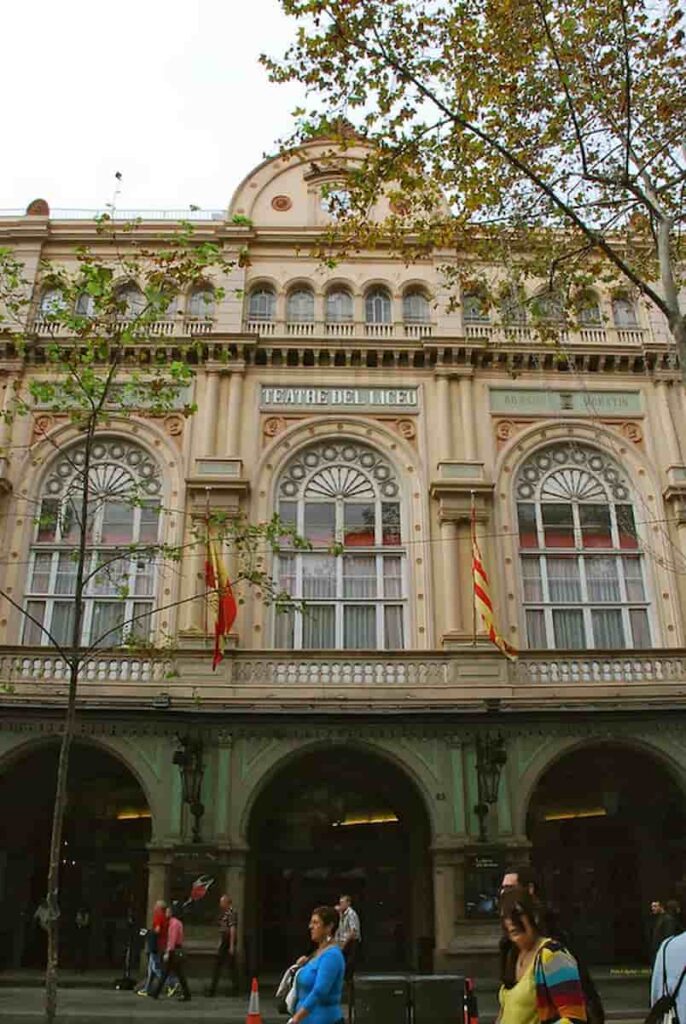
The Gran Teatre del Liceu, commonly known as the Liceu, is Barcelona’s most prestigious opera house and a true icon of the city’s rich cultural heritage. Founded in 1847, the Liceu has been the stage for countless world-class performances, hosting renowned artists and captivating audiences for generations.
The theater’s opulent interior is a feast for the eyes, with plush red velvet seating, gilded decorations, and a magnificent horseshoe-shaped auditorium that creates an intimate atmosphere. The Liceu’s grand stage has seen the premieres of numerous operas, ballets, and symphonic concerts, and continues to be a vital part of Barcelona’s vibrant arts scene.
A visit to the Liceu offers a unique opportunity to immerse yourself in the glamor and elegance of a bygone era, while experiencing the world’s finest performing arts in a truly spectacular setting. Take a look at the events calendar for upcoming performances during your time in Barcelona and consider taking a guided tour to discover the fascinating history and architectural beauty of this cherished cultural institution.
28. Monument a Colom (Christopher Columbus Monument)

The Monument a Colom, or the Christopher Columbus Monument, is an iconic landmark that stands proudly at the end of La Rambla, near the bustling Port Vell. Erected in 1888 for the Universal Exposition, this impressive monument was designed to honor Christopher Columbus and his historic voyage to the Americas.
The towering column, which reaches a height of 60 meters (197 feet), is topped by a bronze statue of Columbus pointing towards the sea. As you stroll around the base of the monument, take a moment to admire the intricate reliefs and sculptures that depict certain scenes from Columbus’s life.
For a truly unforgettable experience, you can even go up the Columbus Monument by taking an elevator up to the observation deck. There, you’ll be rewarded with panoramic views of Barcelona and the Mediterranean Sea.
29. Mercat del Born
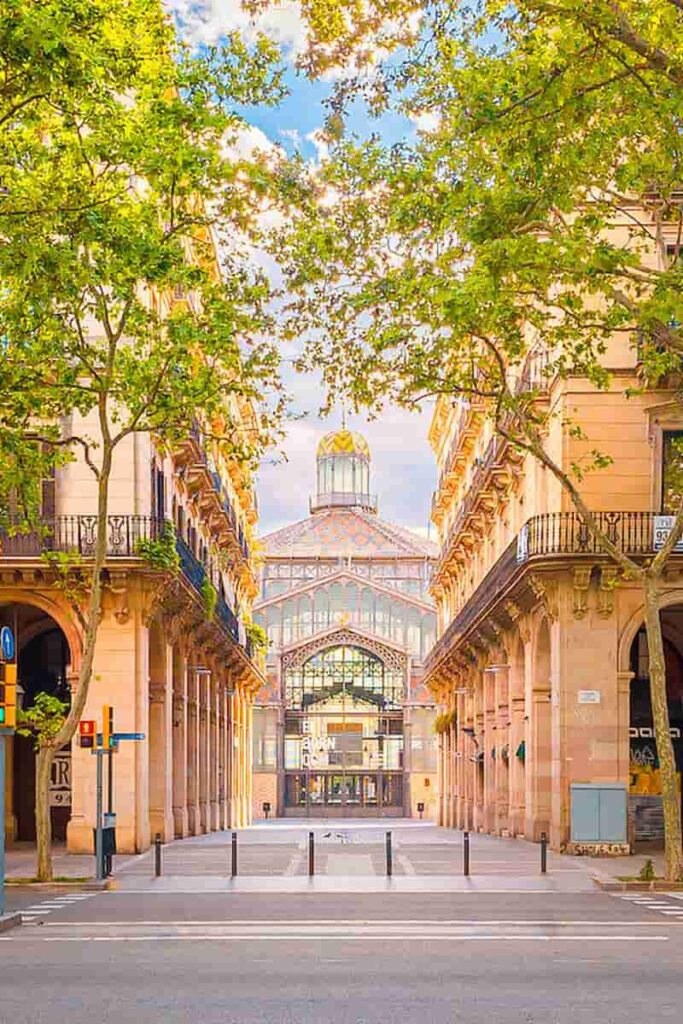
Mercat del Born is a remarkable cultural center housed in a former market building in the heart of the trendy El Born neighborhood. Originally built in the late 19th century, the Mercat del Born was once a bustling marketplace, but the discovery of medieval ruins during renovation works led to its transformation into a unique cultural and historical space.
Today, visitors can explore the well-preserved archaeological remains, which offer a fascinating glimpse into life in medieval Barcelona. The Mercat del Born also hosts temporary exhibitions, workshops, and events that celebrate the city’s rich heritage and vibrant arts scene.
With its stunning Modernist architecture and captivating history, the Mercat del Born is a must-visit destination for anyone seeking to uncover the hidden treasures of Barcelona’s past.
30. Palau de la Generalitat de Catalunya
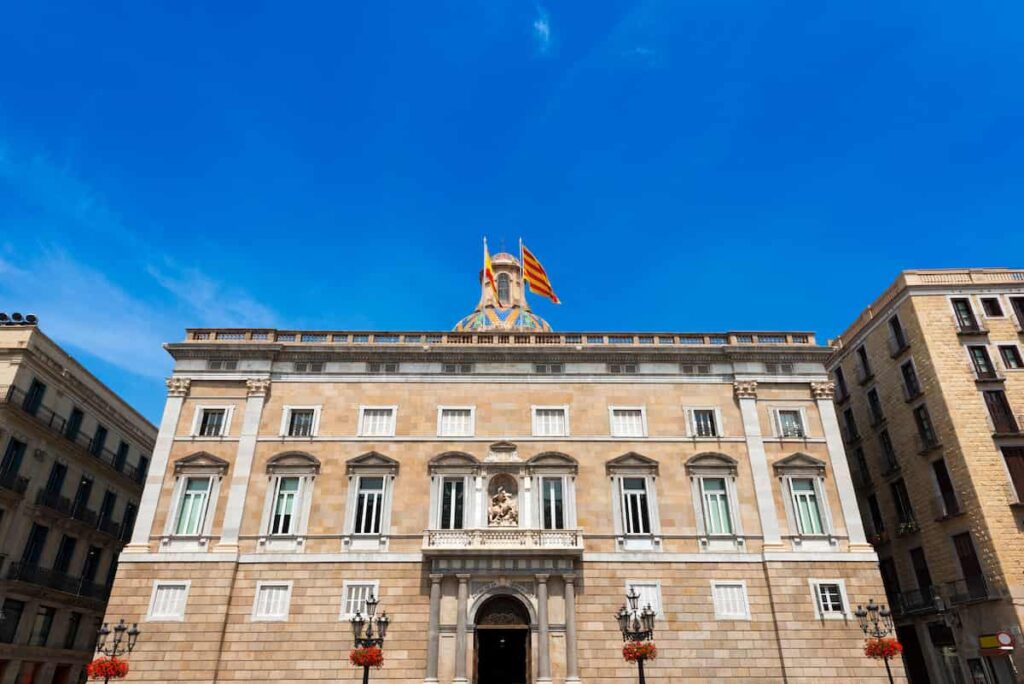
The Palau de la Generalitat de Catalunya is an architectural gem and the seat of the Catalan government, located in the historic Plaça de Sant Jaume. This magnificent building showcases a blend of architectural styles, reflecting the diverse influences that have shaped the city over the centuries.
The striking Gothic façade features intricate stone carvings and elaborate decorations, including a stunning balcony adorned with the Catalan coat of arms and a statue of Saint George, the patron saint of Catalonia. The Renaissance courtyard, with its elegant columns and delicate reliefs, offers a peaceful sanctuary away from the bustling streets outside.
Although the Palau de la Generalitat is not always open to the public, guided tours are occasionally available, providing a rare opportunity to explore the stately rooms and admire the exquisite art and craftsmanship within. \
What is the name of Gaudí’s most famous building in Barcelona?
Antoni Gaudí’s most famous building in Barcelona is undoubtedly the Sagrada Familia, a breathtaking basilica that has become an iconic symbol of the city. The basilica is, however, still under construction and is slated for completion in the coming years.
But despite this, its intricate façades, towering spires, and awe-inspiring interior have already captured the hearts and imaginations of visitors from around the world.
The Sagrada Familia isn’t only a showcase of Gaudí’s unparalleled vision and creativity but also a testament to the enduring power of art and architecture to inspire wonder and awe.

What is the famous colorful building in Barcelona?
One of the most famous colorful buildings in Barcelona is Casa Batlló, designed by the legendary architect Antoni Gaudí. This stunning Modernist masterpiece, located on the prestigious Passeig de Gràcia, is known for its vibrant, organic façade adorned with iridescent mosaic tiles and sinuous balconies.
Casa Batlló is affectionately referred to as the “House of Bones” due to its skeletal appearance, and it stands as a prime example of Gaudí’s unique architectural style and boundless creativity.
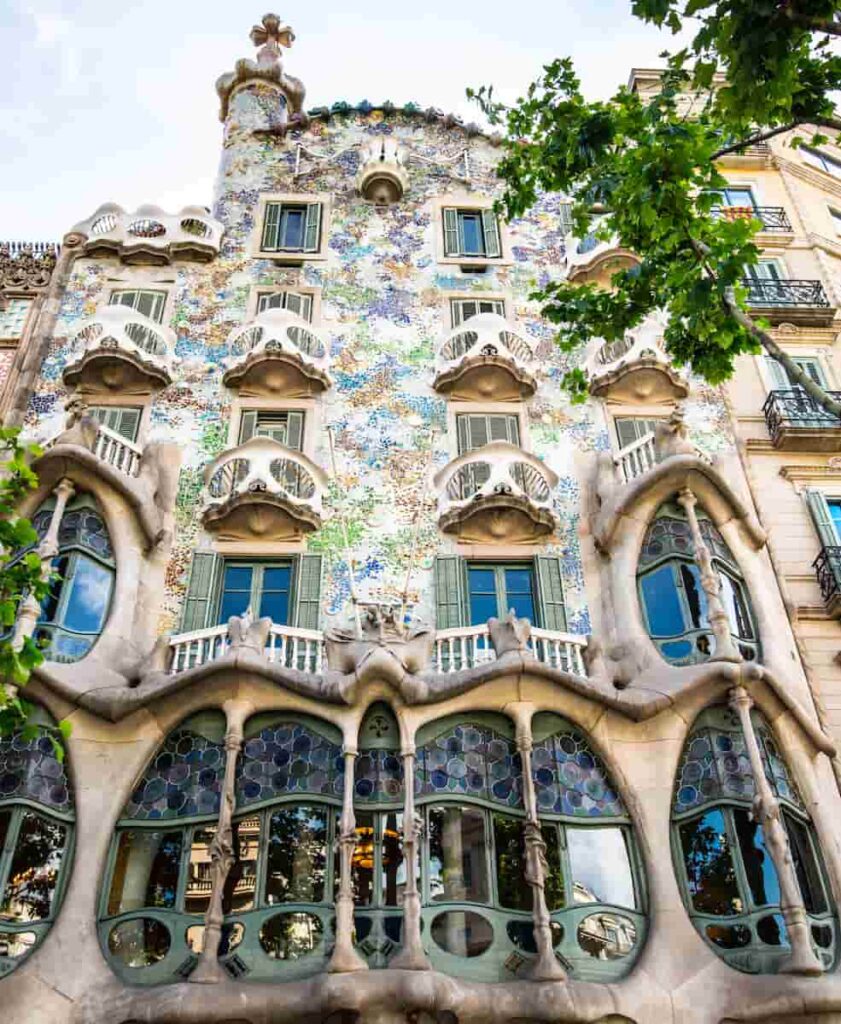
Why is Barcelona architecture famous?
Barcelona’s architecture is famous for its rich history, diverse influences (particularly the impact of Antoni Gaudí), and groundbreaking innovations that have left a lasting impact on the city’s landscape. The city’s architectural heritage spans from Roman ruins to Gothic cathedrals and from Modernist masterpieces to cutting-edge contemporary designs.
It’s clear that one of the key reasons Barcelona’s architecture is so renowned is the city’s association with Gaudí, the visionary architect whose unique style and artistic genius have left an indelible mark on the city. Gaudí’s most famous works, such as the Sagrada Familia, Park Güell, and Casa Batlló, are celebrated for their imaginative designs, intricate craftsmanship, and distinctive aesthetic that defies conventional norms.
In addition to Gaudí’s contributions, Barcelona’s architectural fame can also be attributed to the works of other notable architects, such as Lluís Domènech i Montaner, Josep Puig i Cadafalch, and modern architects like Jean Nouvel and Santiago Calatrava.
The city’s rich architectural tapestry, combining traditional and avant-garde styles, has cemented Barcelona’s reputation as a global hub for architectural innovation and artistic expression.
